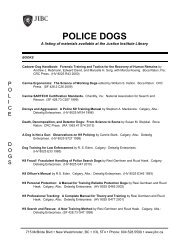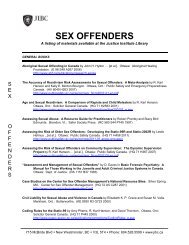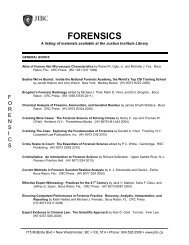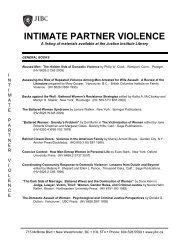legally speaking - Justice Institute of British Columbia
legally speaking - Justice Institute of British Columbia
legally speaking - Justice Institute of British Columbia
You also want an ePaper? Increase the reach of your titles
YUMPU automatically turns print PDFs into web optimized ePapers that Google loves.
DISTURBANCE REQUIRES MORE<br />
THAN CROWD OBSERVING<br />
POLICE MAKE ARREST<br />
R. v. Swinkels, 2010 ONCA 742<br />
In the early morning hours two<br />
police <strong>of</strong>ficers were patrolling<br />
downtown just as the bars were<br />
closing. While they were driving<br />
they heard someone yell obscenities<br />
from within a large crowd <strong>of</strong> about 15 to 20 people<br />
outside a bar. The <strong>of</strong>ficers pulled over to investigate<br />
and, as they exited their vehicle, the accused came<br />
quickly towards one <strong>of</strong> the <strong>of</strong>ficers yelling further<br />
obscenities. Both <strong>of</strong> the accused’s arms were straight<br />
out and his middle fingers were up. Believing he<br />
was about to be assaulted or grabbed, the <strong>of</strong>ficer<br />
took the accused by his shirt, pulled him to the<br />
ground, and arrested him for causing a disturbance.<br />
At trial in the Ontario Superior Court <strong>of</strong> <strong>Justice</strong> on a<br />
charge <strong>of</strong> causing a disturbance the accused was<br />
convicted. The trial judge concluded there was a<br />
disturbance caused by the accused. He caused a<br />
crowd to gather and several members <strong>of</strong> the public<br />
were disturbed. A further appeal to the Ontario<br />
Superior Court <strong>of</strong> <strong>Justice</strong> was dismissed. The accused<br />
then appealed to the Ontario Court <strong>of</strong> Appeal.<br />
Causing a Disturbance<br />
The actus reus for causing a public disturbance by<br />
using obscene language has two components.<br />
1. the accused must have engaged in one <strong>of</strong><br />
the enumerated acts, which includes<br />
“screaming, shouting, swearing, or using<br />
insulting or obscene language.”<br />
2. the accused’s actions must have caused “an<br />
externally manifested disturbance <strong>of</strong> the<br />
public peace, in the sense <strong>of</strong> interference<br />
with the ordinary and customary use<br />
<strong>of</strong> the premises by the public.” Said<br />
another way, an accused’s actions<br />
must involve “violent noise or<br />
confusion disrupting the tranquillity<br />
<strong>of</strong> those using the area in question.”<br />
Volume 11 Issue 1 - January/February 2011<br />
PAGE 28<br />
BY THE BOOK:<br />
Causing a Disturbance<br />
s. 175(1)(a)(i) Criminal Code<br />
Every one who (a) not being in a<br />
dwelling-house, c a u s e s a<br />
disturbance in or near a public<br />
place, (i) by fighting, screaming,<br />
shouting, swearing, singing or<br />
using insulting or obscene<br />
language … is guilty <strong>of</strong> an<br />
<strong>of</strong>fence punishable on summary conviction.<br />
Here, the accused was engaged in one <strong>of</strong> the<br />
enumerated acts. But his conduct did not result in an<br />
“externally manifested disturbance.” “Generally<br />
<strong>speaking</strong> ... shouting obscenities at police <strong>of</strong>ficers is<br />
not a disturbance in and <strong>of</strong> itself,” said <strong>Justice</strong><br />
LaForme <strong>speaking</strong> for a two judge majority. The<br />
objective <strong>of</strong> s. 175(1)(a) is not to protect individuals<br />
from emotional upset, but to protect the public from<br />
disorder calculated to interfere with the public's<br />
normal activities. In this case, a large crowd<br />
gathered around a bar at closing time. The <strong>of</strong>ficer<br />
testified that the scene was “a normal bar type<br />
crowd” and the patio was always packed with very<br />
intoxicated people. It was a warm summer’s night,<br />
the streets were packed, and there was ongoing<br />
yelling in the area. The downtown core was<br />
extremely busy when the bars close.<br />
In this case, the packed and noisy streets just after<br />
bar closing formed the context and surroundings<br />
under which the disruptiveness <strong>of</strong> the accused’s<br />
conduct was to be measured. What could be<br />
expected at this time and place would be different<br />
than what one would expect in the library or super<br />
market. The presence <strong>of</strong><br />
“Generally <strong>speaking</strong> ... the crowd around or near<br />
the accused was not a<br />
shouting obscenities at<br />
disturbance. The crowd<br />
police <strong>of</strong>ficers is not a was already there. The<br />
disturbance in and <strong>of</strong> itself.”<br />
police testified the crowd<br />
they saw was a normal






